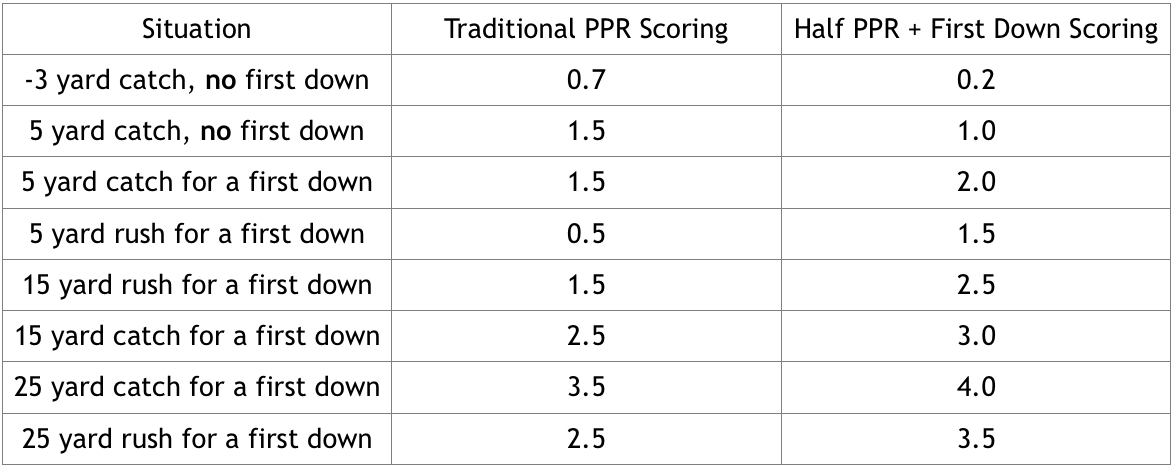Dynasty League Rule Changes: First Down Scoring
The fantasy “off-season” is officially upon us now. Hopefully, this means you have already let your league commissioners know your intentions for the 2019 fantasy season. You’ve already made certain your roster is in compliance with your off-season rules, and you know if there are any deadlines approaching for league fee payments, roster changes, etc. If not, you better stop reading and go figure that out. Don’t worry, I’ll wait for you. All good now? Okay, let’s get back to it.
Now that is all dealt with, it is time to move on to your next task. Unfortunately, it is something that many league owners just don’t participate in at all. It is time to start proposing changes to your league rules and bylaws.
Having a league with well-constructed and thought our bylaws to go with a fair scoring system is one of the key factors in if a league will last for years to come or if it will quickly circle the drain and break up. Much like the NFL, leagues need to change and evolve with the times. Every league should be going through an annual evaluation period of its rules where owners can have open and honest discussions about the things that work and the things that need to be changed. What was great ten years ago when your league started might be an area of concern today.
When I first started writing for DLF almost six years ago, one of my big pushes was to “Kick the Kicker” from dynasty leagues. It took a while, but I think playing without a kicker in dynasty is now the norm. This is just one example of a change that leagues can and should be making as time goes on.
In order to help you out, I have decided to put together a little series with a few ideas for changes you should be proposing and discussing in your leagues. Before I go any further, let me be the first to say that every league is different, and it is important that you do what fits your league and what your owners find enjoyable. If you don’t like an idea or it doesn’t fit with your league’s philosophy, then, by all means, don’t bring it up. These are just some ideas I think are definitely worthy of discussion.
Today’s topic: Points for First Downs
[am4show have=’g1;’ guest_error=’sub_message’ user_error=’sub_message’ ]
Before I get into the details of how this works or why it is necessary, allow me to regale you with a little scenario. I’m a Bears fan, so let me play out this hypothetical with them.
The Bears are on the opponent’s 40-yard line. Tarik Cohen lines up in the backfield. The ball is snapped and Mitchell Trubisky looks downfield before dumping the ball off to Cohen in the flat. Cohen makes a few tacklers miss before running down the sideline. He gets pushed out at the 15-yard line for a 25-yard catch and run. But wait, there is a flag back at the line of scrimmage, and I’m throwing things at my TV. Holding on the Bears. Back to midfield for a first and 20. This time they run a quick pitch to Cohen who makes a defender miss in the hole. He quickly turns it upfield for a 12-yard gain. Second and eight for the Bears now, and I’m no longer throwing things.
Jordan Howard comes in on second down, and the Bears run a draw up the middle. Howard picks up three yards in a cloud of dust. That makes it third and five on the opponent’s 35-yard line. The Bears go no huddle with a quick receiver screen to the outside. Taylor Gabriel makes his defender miss, but Burton misses a block and the defense responds quickly. The defense holds Gabriel to just a three-yard gain. It is now fourth and two on the opponent’s 32-yard line. A lot of teams might try for a field goal, but we have Cody “Upright Magnet” Parkey as our kicker.
The Bears keep the offense on the field, and it seems like Trubisky is trying to draw the defense offsides. Wait, what is this? He actually snapped the ball?! There is a quick slant over the middle of the field, and Trubisky works the ball into a tight window, hitting Allen Robinson for a two-yard pass play, and Robinson manages to hold on even though the linebacker nearly took his head off in the process. They bring the sticks out to measure, and the ball is past the line by almost a full ball length. First and ten, Chicago!
Let’s review the stats from this scenario.
- Cohen: 1 carry for 12 yards
- Howard: 1 carry for 3 yards
- Gabriel: 1 reception for 3 yards
- Robinson: 1 reception for 2 yards
In a traditional PPR scoring, the points go Gabriel 1.3, Cohen 1.2, Robinson 1.2, and Howard 0.3.
Okay, so what is the big deal? One of my biggest frustrations with traditional PPR scoring, even though I run it in most of my leagues, are those two and three-yard receptions counting for as much as a ten-plus-yard rush. Or worse yet, you get the failed screen pass that is one catch for minus-three yards and it gets you positive points when the best things the player could have done for his team is to let the ball bounce at his feet.
In the scenario above, Cohen earned more than half of the yards; however, he earned less than a fourth of the points even though there wasn’t a scoring play. That just doesn’t seem right to me. If fantasy points are supposed to have some resemblance of what people do on the field, then there is no way Gabriel’s contribution was anywhere near, let alone surpassing that of Cohen or Robinson.
Some people would say this is a perfect of example of why you shouldn’t do PPR. I don’t think the solution is quite that simple. After all, Robinson’s big play on fourth down was a huge catch for his team and likely helped them score a few plays later. That catch should be worth more than Howard’s three-yard rush or Gabriel’s three-yard reception, so just getting rid of the PPR scoring doesn’t fix either of those issues. I believe this is where points for first downs come into play!
One thing that I’m going to be proposing in the majority of my leagues this year is to scale back PPR scoring just a little bit while at the same time adding a point for a first down. For all running backs and wide receivers (I’m going to leave tight end PPR alone since they don’t score enough as it is), I’m going to propose 0.5 PPR instead of 1.0 PPR; however, I’m going to add in one point for earning a first down. I’m a big fan of fantasy trying to reflect what is and is not important on the NFL field, and getting a first down is a huge deal. We should reward that.
If we make this adjustment to the scoring for the above scenario, we end up with the following: Robinson 1.7, Cohen 1.2, Gabriel 0.8, Howard 0.3. While it isn’t perfect, I think this order is much closer to representing the various players’ contributions towards their team during the described situation. If you start to add in a few other changes, like some credit for every carry, then we get even closer. More on that in a future article!
Let us look at how this affects scoring in a few other situations:

I love a few different things about the half PPR with a point for a first down scoring system.
1.) It decreases the value of the little dink-and-dunk receptions that don’t actually go anywhere – unless of course, it is a reception that goes for a first down.
2.) It lessens the difference in scoring between yards through the air and yards on the ground while still giving a slight edge to WRs for the purposes of keeping their scoring closer to RBs as a whole.
3.) I love that it gives an extra point to big plays, no matter if they are through the air or on the ground.
4.) It gives a little bonus to those short-yardage specialists. After all, we all know it is much harder to get two yards when it is third and one than it is to get two yards on first and ten.
When you first propose this idea to your league, there will likely be a few people who don’t like it simply because people don’t like change. However, I think you have a few other things you can point to for a little help at convincing people to consider this. One of the premier fantasy football competitions, the Scott Fish Bowl Competition, has adopted first down scoring for the last two years, and it has been very well received. Another big selling point is that it treats all players as equals. Everyone has the chance to get a first down, and getting it is a big deal for their NFL teams. It should matter on your fantasy team as well. If push comes to shove, you could always try to compromise on half of a point for a first down. I think this decreases the “big play” bonus just a little bit, but it is definitely better than nothing.
Next on my list of topics to bring up for a rule change, points for carries.
[/am4show]
- Final 2021 Pre-Draft Rookie Mock: Round Three - April 28, 2021
- Final 2021 Pre-Draft Rookie Mock: Round Two - April 26, 2021
- Final 2021 Pre-Draft Rookie Mock: Round One - April 25, 2021


































































